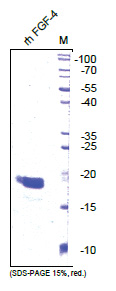Gremlin-1 / GREM1 Human Protein
Other products for "GREM1"
Specifications
| Product Data | |
| Species | Human |
| Expression Host | E. coli |
| Predicted MW | 19.7 kDa |
| Purity | >95% pure by SDS-PAGE and visualised by silver stain |
| Presentation | Purified |
| Buffer | Presentation State: Purified State: Lyophilized purified fraction Buffer System: PBS Stabilizer: None |
| Bioactivity | Biological: The biological activity was determined by the induction of proliferation in NHDF cells (Normal Human Dermal Fibroblasts). |
| Reconstitution | We recommend a quick spin followed by reconstitution in water to a concentration of 0.1-1.0 mg/ml. This solution can then be diluted into other aqueous buffers and stored at 4°C for 1 week or -20°C for future use. |
| Preparation | Lyophilized purified fraction |
| Protein Description | Recombinant Human FGR-4. Result by N-terminal sequencing: MAPTAPNGTL |
| Storage | Store lyophilized at 2-8°C for 6 months or at -20°C long term. After reconstitution store the antibody undiluted at 2-8°C for one month or (in aliquots) at -20°C long term. Avoid repeated freezing and thawing. |
| Stability | Shelf life: one year from despatch. |
| Reference Data | |
| RefSeq | NP_001178251 |
| Locus ID | 26585 |
| UniProt ID | B3KTR9 |
| Cytogenetics | 15q13.3 |
| Synonyms | C15DUPq; CKTSF1B1; CRAC1; CRCS4; DAND2; DRM; DUP15q; GREMLIN; HMPS; HMPS1; IHG-2; MPSH; PIG2 |
| Summary | This gene encodes a member of the BMP (bone morphogenic protein) antagonist family. Like BMPs, BMP antagonists contain cystine knots and typically form homo- and heterodimers. The CAN (cerberus and dan) subfamily of BMP antagonists, to which this gene belongs, is characterized by a C-terminal cystine knot with an eight-membered ring. The antagonistic effect of the secreted glycosylated protein encoded by this gene is likely due to its direct binding to BMP proteins. As an antagonist of BMP, this gene may play a role in regulating organogenesis, body patterning, and tissue differentiation. In mouse, this protein has been shown to relay the sonic hedgehog (SHH) signal from the polarizing region to the apical ectodermal ridge during limb bud outgrowth. Alternatively spliced transcript variants encoding different isoforms have been found for this gene. [provided by RefSeq, Jul 2010] |
| Protein Families | ES Cell Differentiation/IPS, Secreted Protein |
Documents
| FAQs |
| SDS |
Resources
Recombinant Protein Resources |
{0} Product Review(s)
0 Product Review(s)
Submit review
Be the first one to submit a review
Product Citations
*Delivery time may vary from web posted schedule. Occasional delays may occur due to unforeseen
complexities in the preparation of your product. International customers may expect an additional 1-2 weeks
in shipping.






























































































































































































































































 Germany
Germany
 Japan
Japan
 United Kingdom
United Kingdom
 China
China
